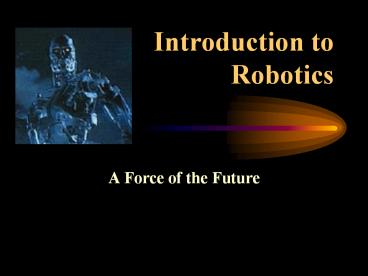Introduction to Robotics - PowerPoint PPT Presentation
Title:
Introduction to Robotics
Description:
Introduction to Robotics A Force of the Future Introduction to Robotics A Force of the Future Revolute (Joined-Arm) Coordinate System - Axis Revolute (Joined-Arm ... – PowerPoint PPT presentation
Number of Views:1447
Avg rating:3.0/5.0
Title: Introduction to Robotics
1
Introduction to Robotics
- A Force of the Future
2
(No Transcript)
3
Robots of the media
4
(No Transcript)
5
- What kinds of robots are there?
- What are the parts of a robot?
- How do robots move?
- How do robots help us?
6
What kinds of robots are there?
7
Types of robots
Simple Level Robots
- are automatic machines that extend human
potential. - do work that humans can but should not do.
8
Types of robots
Middle Level Robots
- are programmable, multipurpose, electromechanical
machines. - do work that humans normally do.
9
Types of robots
Complex Level Robots
- are reprogrammable, multifunctional,
manipulators. - are designed to move materials, tools and parts
through programmed paths. - are suited for a variety of tasks.
10
What are the parts of a robot?
- Manipulator
- Pedestal
- Controller
- End Effectors
- Power Source
11
Manipulator
(Mimics the human arm)
- Base
- Appendages
- Shoulder
- Arm
- Grippers
12
Pedestal
(Human waist)
- Supports the manipulator.
- Acts as a counterbalance.
13
Controller
(The brain)
- Issues instructions to the robot.
- Controls peripheral devices.
- Interfaces with robot.
- Interfaces with humans.
14
End Effectors
(The hand)
- Spray paint attachments
- Welding attachments
- Vacuum heads
- Hands
- Grippers
15
Power Source
(The food)
- Electric
- Pneumatic
- Hydraulic
16
How do robots move?
17
Cartesian Coordinate System
18
Cartesian Coordinate System
X- Axis
19
Cartesian Coordinate System
Y- Axis
20
Cartesian Coordinate System
Z- Axis
21
Cartesian Coordinate System
22
Cylindrical Coordinate System
23
Cylindrical Coordinate System
Y - Axis
24
Cylindrical Coordinate System
Z - Axis
25
Cylindrical Coordinate System
? - Axis
26
Cylindrical Coordinate System
27
Polar (Spherical) Coordinate System
28
Polar (Spherical) Coordinate System
? - Axis
29
Polar (Spherical) Coordinate System
? - Axis
30
Polar (Spherical) Coordinate System
Y - Axis
31
Polar (Spherical) Coordinate System
32
Revolute (Joined-Arm) Coordinate System
33
Revolute (Joined-Arm) Coordinate System
? - Axis
34
Revolute (Joined-Arm) Coordinate System
? - Axis
35
Revolute (Joined-Arm) Coordinate System
? - Axis
36
Revolute (Joined-Arm) Coordinate System
37
Stop !! Time out !!
38
Degrees of Freedom
VS
39
Degrees of Freedom
- Rotating the base.
40
Degrees of Freedom
- Pivot the base of the arm.
41
Degrees of Freedom
- Bending the elbow.
42
Degrees of Freedom
- Wrist up and down.
43
Degrees of Freedom
- Wrist left and right.
44
Degrees of Freedom
- Rotating the wrist.
45
(No Transcript)
46
Applications
- Transporting materials, tools, equipment.
- Assembling parts.
- Quality control.
- Cutting materials.
- Others
47
(No Transcript)
48
- How can robots be classified?
- What are the major parts of a robot?
- How can robots move?
- How can robots help extend our potential?

